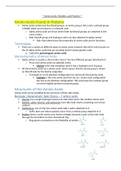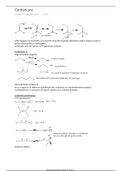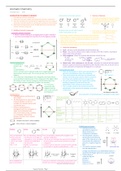Deprotonation Study guides, Class notes & Summaries
Looking for the best study guides, study notes and summaries about Deprotonation? On this page you'll find 40 study documents about Deprotonation.
Page 4 out of 40 results
Sort by

-
Amino Acids, Peptides, and Proteins
- Exam (elaborations) • 111 pages • 2022
-
- $17.99
- + learn more
**Amino Acids, Peptides, and Proteins** Amino Acids Found in Proteins • Amino acids contain two functional groups, an amino group (-NH2) and a carboxyl group (-COOH) which are formed on a carboxylic acid. o Alpha amino acids are those where both functional groups are attached to the same carbon. o Side chain/R group and hydrogen atom are also attached to alpha carbon. Side chain determines the properties of amino acids and its functions. Terminology • There are a variety of differ...

-
MCAT UWorld Exam with Complete Solutions
- Exam (elaborations) • 11 pages • 2022
- Available in package deal
-
- $10.49
- + learn more
Different Nitrogen names - ANSWER Enamine: C=C-N Amine : C-N Imine: C=N Amide: O=C-N Imide: O=C-N-C=O Ketone(aldehyde) + 1° amine --> Imine Ketone(aldehyde) + 2° amine ---> Enamine think about it when replace the Oxygen of carbonyl and attach NitrogenR, /Make sure It has a lone pair. for the 2 ° amine move double bond to the C. Amine - ANSWER C-N Myopia (nearsighted) - ANSWER *(-)F= diverging mirror /convex mirror/concave lens *convex mirror: image always virtual...

-
BCHE 5180 / 6180 FINAL EXAM | Graded A
- Exam (elaborations) • 20 pages • 2022
-
- $13.99
- + learn more
BCHE 5180 / 6180 FINAL EXAM | Graded A 1 3 points Based on what you have learned about the functioning of enzymes and proteins, explain why the pH in the cell has to be buffered. A large group of enzymes show a pH optimum for their activity. This value is normally close to the pH in the cell. When the pH in the cell changes this can lead to a protonation or deprotonation of an amino acid that is important for the enzymatic activity. As a result the activity will decrease. Upon large change...

-
BCHE 5180 / 6180 FINAL EXAM | Graded A
- Exam (elaborations) • 18 pages • 2022
-
- $14.50
- + learn more
BCHE 5180 / 6180 FINAL EXAM | Graded A 1 3 points Based on what you have learned about the functioning of enzymes and proteins, explain why the pH in the cell has to be buffered. A large group of enzymes show a pH optimum for their activity. This value is normally close to the pH in the cell. When the pH in the cell changes this can lead to a protonation or deprotonation of an amino acid that is important for the enzymatic activity. As a result the activity will decrease. Upon large change...

-
BCHE 5180/6180: Spring Final (Graded A+)
- Exam (elaborations) • 15 pages • 2021
-
- $11.99
- + learn more
BCHE 5180/6180: Spring Final (Graded A+) 1 3 points Based on what you have learned about the functioning of enzymes and proteins, explain why the pH in the cell has to be buffered. A large group of enzymes show a pH optimum for their activity. This value is normally close to the pH in the cell. When the pH in the cell changes this can lead to a protonation or deprotonation of an amino acid that is important for the enzymatic activity. As a result the activity will decrease. Upon large chan...

-
BCHE 5180/6180: Spring Final (Graded A+)
- Exam (elaborations) • 15 pages • 2022
-
- $12.49
- + learn more
BCHE 5180/6180: Spring Final (Graded A+) BCHE 5180/6180: Spring Final (Graded A+) 1 3 points Based on what you have learned about the functioning of enzymes and proteins, explain why the pH in the cell has to be buffered. A large group of enzymes show a pH optimum for their activity. This value is normally close to the pH in the cell. When the pH in the cell changes this can lead to a protonation or deprotonation of an amino acid that is important for the enzymatic activity. As a result...

-
CFQ & PP: Carbonyl Chemistry: Survey of Reactions and Mechanisms STUDY GUIDE
- Summary • 23 pages • 2021
-
- $12.49
- + learn more
CFQ & PP: Carbonyl Chemistry: Survey of Reactions and Mechanisms Reading Brown and Foote: Sections 15.1, 16.6 – 16.11, 16.13, 16.14 17.4 – 17.8, 18.2 and 18.4 – 18.12 Lecture Supplement Carbonyl Reaction Catalysis (page 50 of this Thinkbook) Suggested Text Exercises Brown and Foote: Chapter 15: 1, 2 Chapter 16: 4 – 11, 12 – 14, 19 – 45, 54 – 68 Chapter 17: 2 – 5, 18 – 43 Chapter 18: 2 – 12, 20 - 53 Optional Interactive Organic Chemistry CD and Workbook Supporting...

-
Monofunctional Carbonyls Notes
- Class notes • 18 pages • 2020
-
- $3.85
- + learn more
Carbanions are looked at with examples and how to stabilise through inductive and resonance effects. Enolate formation reaction is introduced and a look at different bases and how complete deprotonation can be. The stabilisation of enolates develops the topic before the α-halogenation by base or acid catalysed reactions. More enolate reactions are given. Alkylate aldehydes formation through enamines. Aldol reaction through acid and base conditions in either equilibrating and non-equilibrating c...


-
Aromatic Chemistry
- Summary • 7 pages • 2019
-
Available in package deal
-
- $4.49
- + learn more
I got a 1st in my first year studying chemistry at the University of Birmingham using these revision notes that I have uploaded. They include detail on structure of benzene, stability of aromatic compounds, criteria for aromaticity, electrophilic substitution, benzene vs olefin reactivity with electrophiles, arrow-pushing mechanisms for a range of electrophilic aromatic substitution reactions, functional group interconversion, selectivity in substitution reactions, how substitutents on a benzene...

That summary you just bought made someone very happy. Also get paid weekly? Sell your study resources on Stuvia! Discover all about earning on Stuvia



